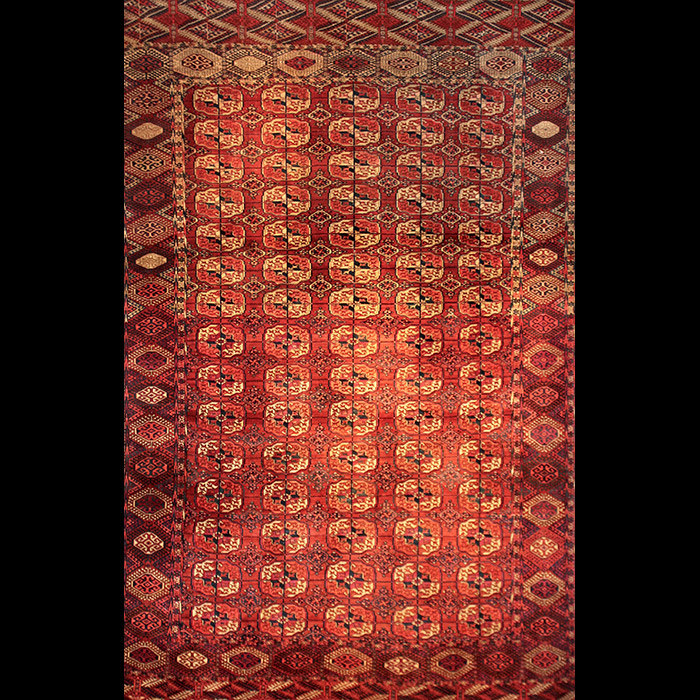Clay Stewart Collection of Türkmen Textiles
13. Türkmen Ahal Teke Main Rug
Ca. 1870. Size: 7 ft. x 11 ft. 2 in.
Ca. 1870. Size: 7 ft. x 11 ft. 2 in.

10 x 16 = 160 asymmetrical kpsi, pulled open to the right, resulting in a width/height ratio of 5:8. Two cords each x two in four cord side edge S-ply warps of natural ivory wool), single gold wool strand, twisted weft inserted in alternating depressed warp Senneh weave configuration, in a horizontal line, under and over the warps between the rows of knots., one invisible weft (from the back) wraps around the inner 2-cables and another below wraps around the outer 2 caqbles, each double cable thus wrapped alternately by one inner gold weft and then the outer weft wraps the outer double cable, all four cables are then evenly overcast with dark blue wool yarn. Two wool weft shoots is a Merv Teke feature: Moshkova. Many flat nodes (symmetrical) viewed from the back is an Akhal feature: Moshkova, and many other knots have slight warp depressions (a Merv Teke feature) also viewed as a slightly ribbed effect from the back. The weave and wool all point to an Akhal Teke attribution. Also, the weave is not quite as sophisticated as you might expect from a fine Merv Teke Main Rug, nor the quality of dye and wool is not as fine as in the Merv Oasis in the last quarter 19th century. Supple handle. 4 in. aprons (flat woven top and bottom ends) woven from warps as described with the same cable for the wefting. Medium pile cut height.
15 gush go:ls (traditional Teke Main rug go:ls, a hybrid that includes bird totems and agricultural totems, and is the hereditary Emblem of the Teke Turkmen tribe. Field has five vertical columns of 15 gush go:ls, columned with corresponding 15 horizontal bands with 5 gush go:ls on each. Each of the major go:ls has their reciprocal minor gurbaga guls. The inner frame of the field shows half minor gurbaga guls protruding into the field. The alternating stars in the major border are dark light day night representations of the Sun as it encircles the tribe during their yearly migration and this motif is called Shelpe Golcha (Moshkova). Minor guard borders have repeated gochanak symbols and other minor borders guarding them have repeated Soldat symbols. Lower and upper elems show the tree motif. Five vertical and 15 horizontal rows of Go:ls are each connected by a blue line.
The most striking and unusual feature of this rug is the appearance of the top half being much lighter than the bottom half. In line with the half day-half night symbol taken from their lives as a yen yang, light dark, day night symbol.
A symbol of status in a large Teke Turkmen tribe.These main rugs display the heraldic traditional emblem of the tribe and are displayed during functions celebrating family get togethers in honor of visitors. Only the wealthy chiefs could own one.
Akhal Oasis, Goek Tepe, 40 miles west of Ashkabad, Turkmenia.
Visit Glossary page for any further definitions not highighted in red in a pop-up window.